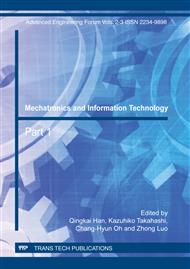[1]
Jan Swevers, Walter Verdonck, and Joris De Schutter. Dynamic Model Identification for Industrial Robots, IEEE Control Systems Magazine, 27(5), 2007: 58-71.
Google Scholar
[2]
Zhang Xingguo, Xu Haili. Analysis on Struture and Kinematics of FANUC M-6iB Industrial Robot. Journal of Nantong University (Natural Science Edition), 8(1), 2009: 9-12.
Google Scholar
[3]
Rafael M. Inigo, James S. Morton. Simulation of the Dynamics of an Industrial Robot, IEEE TRANSACTIONS on Education, 34(1), 1991: 89-99.
DOI: 10.1109/13.79887
Google Scholar
[4]
Li Qingling, Zhao Yongsheng. Dynamic Analysis and Simulation of 6-DOF Industrial Robot, Journal of Shanghai Dianji University, 11(4), 2008: 275-278.
Google Scholar
[5]
Yanjie Liu, Lining Sun and Zhenwei An. An Approach for Generating High Velocity and High Acceleration Trajectories of Industrial Robots, Proceedings of 2005 IEEE International Conference in Robotics and Automation, Espoo, Finland, June 27-30, 2005, pp.199-204.
DOI: 10.1109/cira.2005.1554277
Google Scholar
[6]
Gwang-Jo Chung, Doo-Hyung Kim, Hyuk Shin. Structural Analysis of 600Kgf Heavy Duty Handling Robot, Proceedings of 2010 IEEE Conference on Robotics, Automation and Mechatronics, pp.40-45.
DOI: 10.1109/ramech.2010.5513216
Google Scholar
[7]
Fariborz Behi and Delbert Tesar. Parametric Identification for Industrial Manipulators Using Experimental Modal Analysis. IEEE Transactions on Robotics and Automation, 7(5), 1991, pp.642-652.
DOI: 10.1109/70.97876
Google Scholar
[8]
Oguzhan KARHHAN, Zafer BINGUL. Modelling and Identification of STAUBLI RX-60 Robot1, Proceedings of 2008 IEEE International Conference on Robotics, Automation and Mechatronics, pp.78-83.
DOI: 10.1109/ramech.2008.4681356
Google Scholar
[9]
Gwang-Jo Chung, Doo-Hyung Kim, Chan-Hoon Park. Analysis and Design of Heavy Duty Handling Robot, Proceedings of 2008 IEEE International Conference on Robotics, Automation and Mechatronics, pp.774-778.
DOI: 10.1109/ramech.2008.4681502
Google Scholar
[10]
Chang-Min Ko, Gwang-Jo Chung, Doo-Hyung Kim. Designing of Heavy Duty Handling Robot, Proceedings of the 2009 IEEE International Conference on Mechatronics, Malaga, Spain, April (2009).
DOI: 10.1109/icit.2009.4939718
Google Scholar


